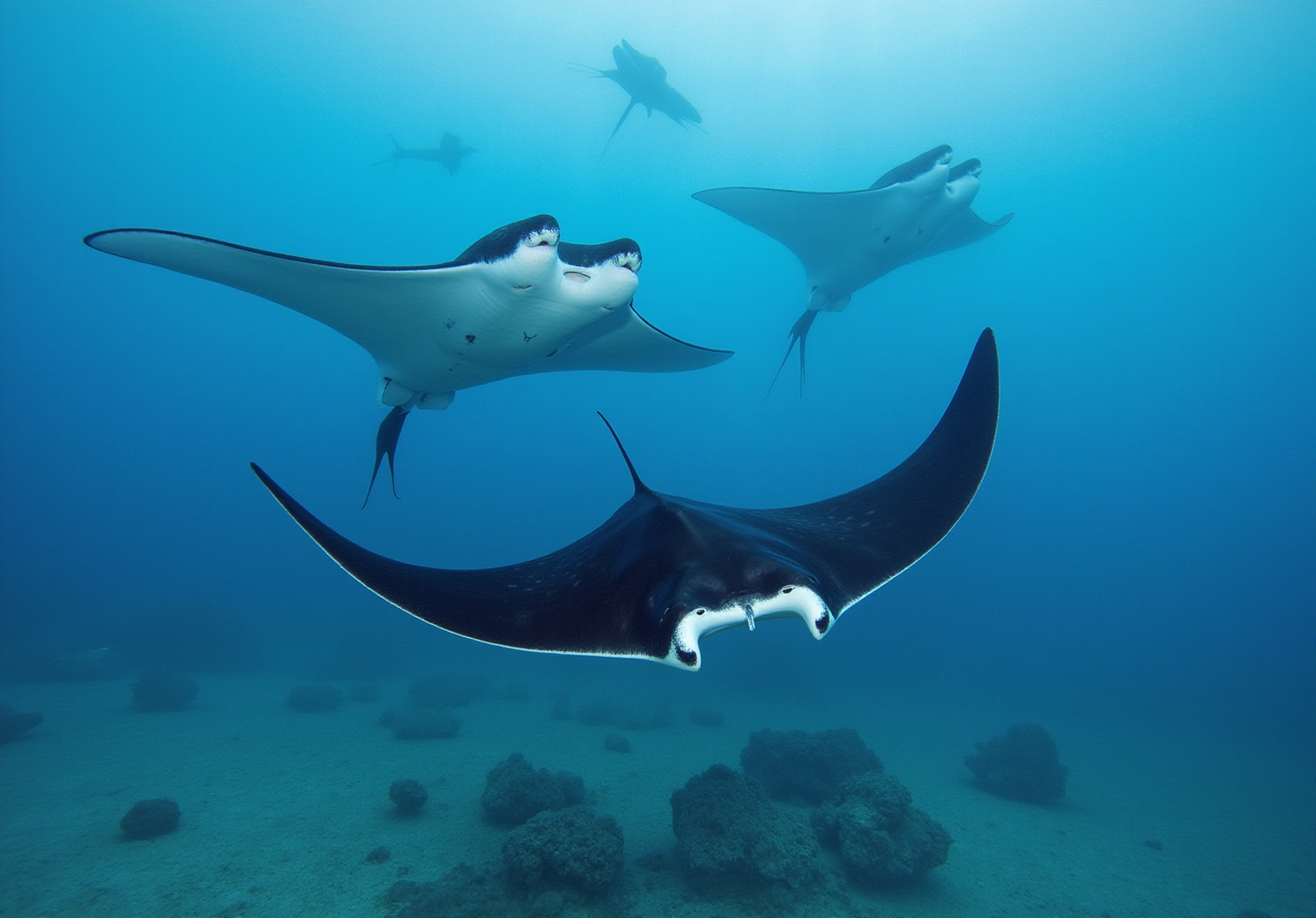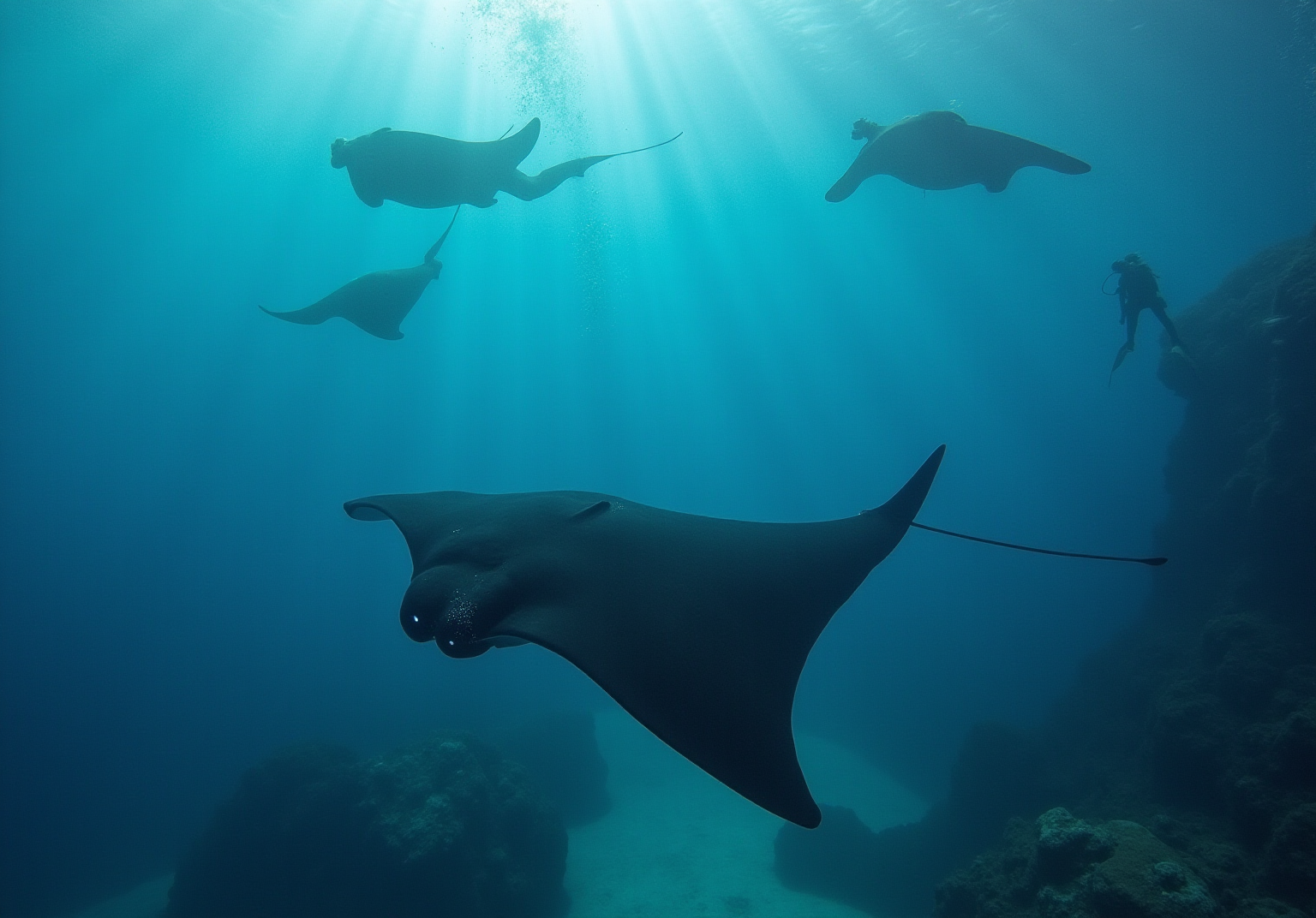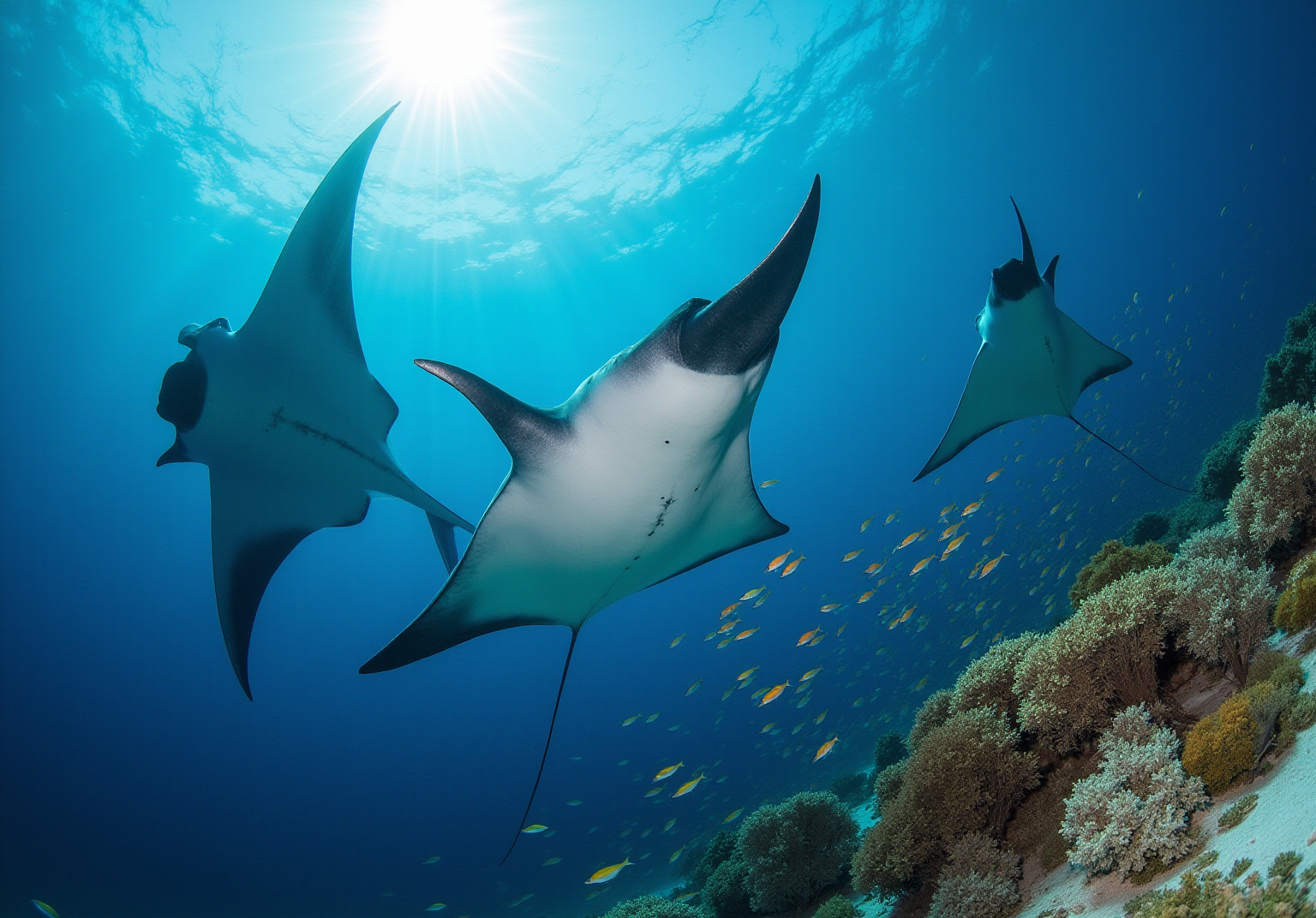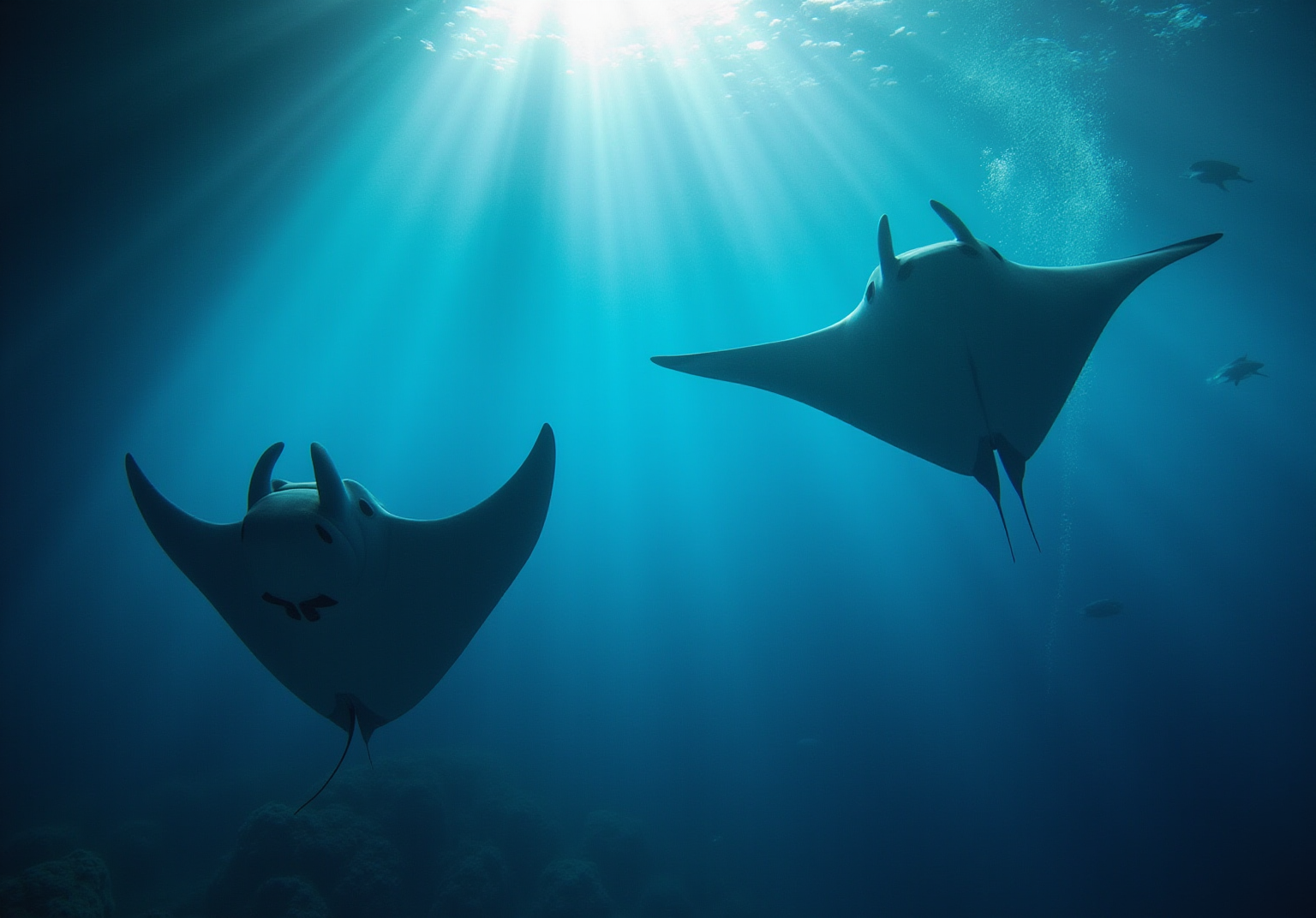Overview
Imagine gliding through the crystalline waters of the Maldives, where the graceful manta rays dance beneath the surface, their wings gliding like silk in the gentle currents. These magnificent creatures, with their expansive wingspans and serene demeanor, invite you into a world where time slows, and the beauty of marine life unfolds in breathtaking detail. Each encounter is not just a sight to behold, but a profound connection to the ocean's depths, where the vibrant colors of coral reefs and the soft whisper of the waves create a symphony of sensations.
As you immerse yourself in this aquatic paradise, the rich tapestry of the Maldives reveals itself. Here, the delicate balance of nature is palpable, reminding us of the urgent need for conservation. The threats posed by human activities and climate change loom large, urging a collective responsibility for the preservation of these majestic beings. Witnessing the manta rays in their natural habitat transcends mere observation; it becomes a call to action, an invitation to embrace responsible tourism and champion conservation efforts that protect the fragile ecosystems we cherish.
In this enchanting realm, the legacy of the manta fish extends beyond their graceful presence. It invites reflection on our relationship with nature and the impact of our choices. As you float among these gentle giants, consider the deeper meaning of luxury — not in opulence, but in the moments that connect us to the world around us. This is where true richness lies, in the awe-inspiring encounters that linger long after the journey ends.
Introduction
Imagine a world beneath the waves, where graceful manta rays glide through vibrant coral gardens, captivating all who encounter them. The gentle undulations of their wings create a mesmerizing dance, inviting you to witness the splendor of marine life. Each encounter feels like a whispered secret from the ocean, a moment suspended in time that beckons you to dive deeper into its mysteries. In the idyllic Maldives, this underwater ballet offers not just a glimpse into the realm of these majestic creatures, but an opportunity for transformative experiences that linger in the heart.
As you immerse yourself in this aquatic paradise, the allure of swimming alongside these gentle giants grows ever stronger. Picture yourself gliding through crystal-clear waters, the sun filtering through the waves, illuminating the vibrant hues of coral. The soft sounds of the ocean envelop you, creating a symphony that resonates with the rhythm of life beneath the surface. Yet, amidst this beauty, an urgent call to action emerges. The threats facing these magnificent beings are ever-present, reminding us of our responsibility to protect their fragile ecosystem. What can we do to ensure that future generations can share in the magic of these romantic underwater encounters?
In this delicate balance of wonder and urgency, we find a deeper meaning. The Maldives is not just a destination; it is a sanctuary for those seeking connection with nature. Each moment spent with manta rays is a reminder of the intricate web of life that sustains our planet. As we reflect on these experiences, let us carry forward the message of conservation, embracing the philosophy that luxury is not merely about indulgence, but about cherishing and preserving the beauty that surrounds us.
Explore Manta Ray Classification and Characteristics
Imagine gliding through azure waters, where the graceful silhouettes of Mobulidae dance beneath the surface. This family of rays, including the majestic Giant Ray (Mobula birostris), the enchanting Reef Ray (Mobula alfredi), and the newly recognized Atlantic Ray (Mobula yarae), captivates with their unique traits, each contributing to the delicate balance of their oceanic realm.
The Giant Ray, a true marvel of the sea, boasts an impressive wingspan that can reach up to 26 feet (8 meters). As it traverses the open ocean, this highly migratory species embarks on epic journeys in search of sustenance, embodying the spirit of freedom and exploration. Picture the thrill of witnessing such grandeur in its natural habitat, a reminder of the vastness and wonder of our oceans.
In contrast, the Reef Ray, smaller yet equally captivating, finds solace in coastal waters. Its more localized movements lead it to vibrant cleaning stations, where smaller fish tenderly remove parasites from its skin, a ritual that speaks to the interconnectedness of marine life.
Then there’s the Atlantic Mobula Ray (Mobula yarae), formally recognized in 2017, distinguished by its unique markings, including 'V-shaped' white shoulder patches. This species, with its lighter hues around the mouth and eyes, faces vulnerabilities from boat strikes and fishing entanglements, emphasizing the urgent need for conservation. Jessica Pate, a research scientist at the Marine Megafauna Foundation, poignantly notes, "Now that we’ve proven that this Atlantic ray is distinct, we can tailor our research and conservation initiatives to protect the species."
These aquatic wonders known as manta fish, defined by their large, diamond-shaped bodies and triangular pectoral fins, glide through the water with elegance. Their dark dorsal side and lighter ventral side serve as effective camouflage against predators, a testament to nature's artistry. Understanding these traits not only enhances your snorkeling or diving experience in the Maldives but also deepens your connection to these magnificent beings, leaving you with a lasting impression of awe and appreciation for the beauty of the natural world.

Examine Manta Ray Behavior and Social Interactions
Imagine the gentle sway of the ocean as large skates glide gracefully through the water, their intricate social behaviors on full display. In the warm embrace of the sea, they gather in harmonious groups, especially during feeding times, forming vibrant aggregations at cleaning stations where smaller fish diligently remove parasites from their bodies. This captivating ritual not only promotes their health but also offers a unique opportunity for divers to witness these majestic creatures up close, forging a connection that transcends the ordinary.
As you watch, the playful acrobatics of these oceanic giants unfold before your eyes—swimming in circles, their movements are a dance of elegance and curiosity. They often approach divers, drawn by an innate curiosity that invites a deeper interaction. Understanding these behaviors enriches your experience, allowing you to appreciate their intelligence and grace while honoring the delicate balance of their world. What if this moment of connection could redefine your perception of luxury, transforming it into an intimate encounter with nature?
In this enchanting underwater realm, each encounter with the skates becomes a signature moment, a reminder of the beauty that lies beneath the surface. The experience lingers long after you've surfaced, echoing in your thoughts—a testament to the profound connection between humanity and the ocean's wonders. Here, time unfolds differently, inviting you to reflect on the extraordinary simplicity of these interactions, and the lasting impact they leave on your soul.

Investigate Manta Ray Habitat and Migration Patterns
Imagine the sun-drenched waters of the Maldives, where giant oceanic species glide gracefully through the crystalline depths. Here, in the embrace of tropical and subtropical currents, manta fish dance among the vibrant tapestry of marine life, drawn to areas rich with plankton—their primary sustenance. As you stand on the warm sands, the allure of the ocean beckons, whispering secrets of the underwater world.
At renowned cleaning stations like Hanifaru Bay and Fushifaru Thila, the spectacle unfolds. Picture manta fish gathering in harmony, their majestic wings outstretched as smaller fish diligently remove parasites, a ritual of rejuvenation that captivates the senses. This is not merely a sight; it’s a moment steeped in the rhythm of nature, where the ocean’s pulse synchronizes with your own.
As dusk approaches, these migratory creatures embark on their long journeys, traversing vast distances in search of nourishment. The peak season from May to November invites you to witness their congregation in large numbers, a breathtaking display that lingers in the heart. Understanding these environments and migration patterns enriches your journey, enhancing the likelihood of encountering these magnificent manta fish species during your time in the Maldives. Each encounter is a gem, a memory that transforms your experience into something profoundly meaningful.

Understand Manta Ray Conservation and Threats
Imagine the vast expanse of the ocean, where the gentle sway of the waves whispers secrets of the deep. Here, large oceanic creatures glide through the cerulean waters, yet they face peril from human hands. Overfishing, habitat destruction, and climate change cast shadows over their existence, threatening the delicate balance of marine life. As we delve into this world, we uncover the urgent conservation issues at play.
Overfishing emerges as a stark reality, with manta fish often hunted for their gill plates, prized in traditional medicine and cuisine. The echoes of Jean-Michel Cousteau, an ocean conservationist, resonate: "The foundation of all life is in the ocean." His words remind us of the profound importance of safeguarding these majestic beings. As we reflect on their plight, we can almost feel the weight of their diminishing numbers.
- Habitat loss further complicates their survival. The relentless march of coastal development and pollution threatens the fragile ecosystems where these pelagic giants thrive. A recent incident, where a giant sea creature was captured for an Abu Dhabi aquarium, sparked public outrage, illuminating the urgent need for conservation efforts. It compels us to consider: what legacy do we wish to leave behind?
As we gaze into the future, climate change looms large. Rising ocean temperatures and acidification disrupt the availability of plankton, their primary food source. Brian Mast, a Republican representative, voices concerns about this crisis, remarking, "This practice raises fundamental concerns about the FWC’s role in upholding its mission of conservation and wildlife preservation." His insights prompt us to ponder our collective responsibility in this unfolding narrative.
Yet, glimmers of hope shine through. Conservation efforts are underway globally, with the establishment of marine protected areas and regulations to limit fishing. A bipartisan group of Florida legislators passionately advocates for the wildlife agency to revoke permits for capturing these large fish, showcasing a commitment to responsible tourism and conservation. Imagine joining this movement, selecting eco-friendly tour operators, engaging in conservation programs, and amplifying awareness about the significance of protecting these creatures and their environments.
Resources abound, offering downloadable ebooks and guides to swimming with manta fish, empowering visitors to take actionable steps toward preserving these magnificent creatures and the ecosystems they inhabit. As we reflect on this journey, we are left with an emotional takeaway: the ocean's beauty is intertwined with our choices, and together, we can forge a path toward a more sustainable future.

Conclusion
In the enchanting waters of the Maldives, the experience of encountering manta rays transcends mere observation, transforming into a profound connection with nature. Picture yourself gliding through crystal-clear waters, where these magnificent creatures, with their graceful movements and social behaviors, invite divers and snorkelers to engage with the ocean's beauty. Understanding their classification, behavior, habitat, and the pressing conservation challenges they face enhances this romantic encounter, making it a journey of both discovery and responsibility.
The article delves into the distinct characteristics of various manta ray species, their intricate social interactions, and their migratory patterns that highlight the delicate balance of marine ecosystems. It underscores the urgent need for conservation amidst threats such as overfishing, habitat destruction, and climate change, reminding us of the impact human actions have on these majestic beings. By embracing eco-friendly practices and supporting conservation efforts, individuals can play a part in safeguarding the future of manta rays and their habitats.
Ultimately, the allure of swimming alongside manta rays in the Maldives serves as a powerful reminder of the interconnectedness of life beneath the waves. Each encounter not only enriches personal experiences but also fosters a deeper appreciation for the ocean's wonders. As stewards of the sea, it is vital to advocate for the protection of these incredible creatures, ensuring that future generations can also bask in the beauty of a world where manta rays glide gracefully through the azure depths.
Frequently Asked Questions
What is the family of rays discussed in the article?
The article discusses the Mobulidae family of rays, which includes the Giant Ray (Mobula birostris), Reef Ray (Mobula alfredi), and the Atlantic Ray (Mobula yarae).
How large can the Giant Ray grow?
The Giant Ray can reach an impressive wingspan of up to 26 feet (8 meters).
What is the habitat of the Reef Ray?
The Reef Ray finds solace in coastal waters and engages in localized movements, often visiting vibrant cleaning stations.
What unique features distinguish the Atlantic Mobula Ray?
The Atlantic Mobula Ray, recognized in 2017, is distinguished by its unique markings, including 'V-shaped' white shoulder patches and lighter hues around the mouth and eyes.
What threats does the Atlantic Mobula Ray face?
The Atlantic Mobula Ray faces vulnerabilities from boat strikes and fishing entanglements, highlighting the need for conservation efforts.
What is the significance of understanding manta rays' characteristics?
Understanding the characteristics of manta rays enhances snorkeling or diving experiences and deepens the connection to these magnificent beings, fostering appreciation for marine life.
How do manta rays use camouflage?
Manta rays have a dark dorsal side and a lighter ventral side, which serve as effective camouflage against predators.




